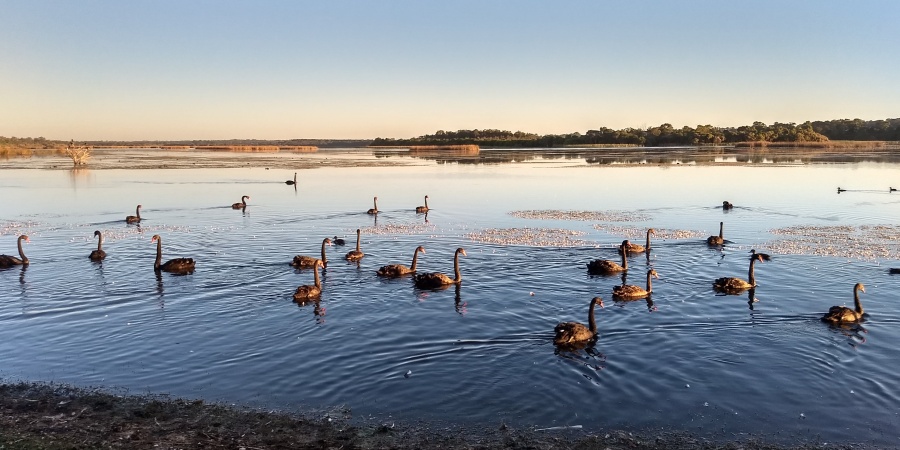
Lake Joondalup. Photo by Fiona Felton/DBCA
Wetlands are areas that are permanently, seasonally or intermittently waterlogged or inundated with water. This water can be fresh or salty, flowing or still and the wetland can occur naturally, or may be artificially created.
Wetlands are important systems providing ecosystem services to all Australians and our environment. Here are some of the important roles that they provide:
- Australian wetlands are critical to the survival of birds that migrate across the globe each season, and Australia is responsible for these birds under international treaties.
- Nearly 20 per cent of Australia’s bird species depend on wetlands, often utilising different wetlands for different parts of their life cycle and daily requirements.
- Wetlands provide a home for other animals such as fish, frogs, tortoises and invertebrates, and many types of plants. They provide vital habitat for threatened plants and animals, such as the western swamp tortoise (Pseudemydura umbrina) found naturally in only two wetlands in the state's south west. They provide nursery areas and breeding grounds for wildlife, particularly fish, frogs and waterbirds.
- Wetlands help keep water clean and healthy by filtering out pollutants such as sediments, nutrients and pathogens.
- Wetlands help reduce the severity of floods and provide refuges for wildlife, especially during drought.
- Many are great spots for recreational activities such as camping, swimming, boating, fishing, bushwalking and birdwatching.
- Many wetlands are culturally significant, for example gnammas (hollows or holes in rock, which were important water sources for Aboriginal people).
- They provide educational and scientific research sites for the community and academic institutions.
Although Australia is the driest inhabited continent, it has a large number of the world’s internationally recognised wetlands.
Wetland type (classification)
In Western Australia we use a geomorphic wetland classification system, which considers the wetland’s landform and hydro-period (Seminuk 1997) to define wetland types.
Lakes are an easily identified type of wetland. These permanently inundated basins are well documented world-wide and notable in our dry landscapes. As shown in the table below there are also less familiar wetland types including sumplands, damplands, playas and palusplains.
| Basin | Flat | Channel | Slope | Highland | |
|---|---|---|---|---|---|
| Permanently inundated | Lake | River | |||
| Seasonally inundated | Sumpland | Floodplain | Creek | ||
| Intermittent inundation | Playa | Barlkarra | Wadi | ||
| Seasonally waterlogged | Dampland | Palusplain | Trough | Paluslope | Palusmont |
| Marine influence | Estuary - Waterbody | Estuary - Peripheral | Estuary - Waterbody |
Waterlogged wetlands are being lost at a faster rate than other wetland types. Since European settlement they have tended to be less valued than other wetlands. They have also posed less of a constraint to development or use because they hold less water.
Wetland management categories (evaluation)
In Western Australia, wetland management categories are used to provide an indication of the relative values of a wetland, and guidance on the management and protection it should be afforded.
Some of our wetland datasets, such as the “Geomorphic Wetlands of the Swan Coastal Plain”, have been assigned wetland management categories. Wetlands can be assigned wetland management categories of Conservation, Resource Enhancement or Multiple Use.
| Management category | General description | Management objectives |
|---|---|---|
| Conservation | Wetlands which support a high level of attributes and functions | Highest priority wetlands. To preserve and protect the existing conservation values of the wetlands through various mechanisms including:
No development or clearing is considered appropriate. These are the most valuable wetlands and any activity that may lead to further loss or degradation is inappropriate. |
| Resource enhancement | Wetlands which may have been partially modified but still support substantial ecological attributes and functions | Priority wetlands Ultimate objective is to manage, restore and protect towards improving their conservation value. These wetlands have the potential to be restored to Conservation category. This can be achieved by restoring wetland function, structure and biodiversity. |
| Multiple use | Wetlands with few remaining important attributes and functions | Use, development and management should be considered in the context of ecologically sustainable development and best management practice catchment planning through landcare. |
*Wetland management categories and objectives applied to the Swan Coastal Plain (Environmental Protection Authority 2008).
For more information on mapping of wetland extent (wetland identification and delineation) and management categories (wetland evaluation) please see the Propose a change to a wetland dataset page.




